Chenyang Zhao
Revisiting Training-Inference Trigger Intensity in Backdoor Attacks
Mar 15, 2025Abstract:Backdoor attacks typically place a specific trigger on certain training data, such that the model makes prediction errors on inputs with that trigger during inference. Despite the core role of the trigger, existing studies have commonly believed a perfect match between training-inference triggers is optimal. In this paper, for the first time, we systematically explore the training-inference trigger relation, particularly focusing on their mismatch, based on a Training-Inference Trigger Intensity Manipulation (TITIM) workflow. TITIM specifically investigates the training-inference trigger intensity, such as the size or the opacity of a trigger, and reveals new insights into trigger generalization and overfitting. These new insights challenge the above common belief by demonstrating that the training-inference trigger mismatch can facilitate attacks in two practical scenarios, posing more significant security threats than previously thought. First, when the inference trigger is fixed, using training triggers with mixed intensities leads to stronger attacks than using any single intensity. For example, on CIFAR-10 with ResNet-18, mixing training triggers with 1.0 and 0.1 opacities improves the worst-case attack success rate (ASR) (over different testing opacities) of the best single-opacity attack from 10.61\% to 92.77\%. Second, intentionally using certain mismatched training-inference triggers can improve the attack stealthiness, i.e., better bypassing defenses. For example, compared to the training/inference intensity of 1.0/1.0, using 1.0/0.7 decreases the area under the curve (AUC) of the Scale-Up defense from 0.96 to 0.62, while maintaining a high attack ASR (99.65\% vs. 91.62\%). The above new insights are validated to be generalizable across different backdoor attacks, models, datasets, tasks, and (digital/physical) domains.
Grad-ECLIP: Gradient-based Visual and Textual Explanations for CLIP
Feb 26, 2025Abstract:Significant progress has been achieved on the improvement and downstream usages of the Contrastive Language-Image Pre-training (CLIP) vision-language model, while less attention is paid to the interpretation of CLIP. We propose a Gradient-based visual and textual Explanation method for CLIP (Grad-ECLIP), which interprets the matching result of CLIP for specific input image-text pair. By decomposing the architecture of the encoder and discovering the relationship between the matching similarity and intermediate spatial features, Grad-ECLIP produces effective heat maps that show the influence of image regions or words on the CLIP results. Different from the previous Transformer interpretation methods that focus on the utilization of self-attention maps, which are typically extremely sparse in CLIP, we produce high-quality visual explanations by applying channel and spatial weights on token features. Qualitative and quantitative evaluations verify the effectiveness and superiority of Grad-ECLIP compared with the state-of-the-art methods. Furthermore, a series of analysis are conducted based on our visual and textual explanation results, from which we explore the working mechanism of image-text matching, the strengths and limitations in attribution identification of CLIP, and the relationship between the concreteness/abstractness of a word and its usage in CLIP. Finally, based on the ability of explanation map that indicates text-specific saliency region of input image, we also propose an application with Grad-ECLIP, which is adopted to boost the fine-grained alignment in the CLIP fine-tuning. The code of Grad-ECLIP is available here: https://github.com/Cyang-Zhao/Grad-Eclip.
ParallelComp: Parallel Long-Context Compressor for Length Extrapolation
Feb 20, 2025Abstract:Efficiently handling long contexts is crucial for large language models (LLMs). While rotary position embeddings (RoPEs) enhance length generalization, effective length extrapolation remains challenging and often requires costly fine-tuning. In contrast, recent training-free approaches suffer from the attention sink phenomenon, leading to severe performance degradation. In this paper, we introduce ParallelComp, a novel training-free method for long-context extrapolation that extends LLMs' context length from 4K to 128K while maintaining high throughput and preserving perplexity, and integrates seamlessly with Flash Attention. Our analysis offers new insights into attention biases in parallel attention mechanisms and provides practical solutions to tackle these challenges. To mitigate the attention sink issue, we propose an attention calibration strategy that reduces biases, ensuring more stable long-range attention. Additionally, we introduce a chunk eviction strategy to efficiently manage ultra-long contexts on a single A100 80GB GPU. To further enhance efficiency, we propose a parallel KV cache eviction technique, which improves chunk throughput by 1.76x, thereby achieving a 23.50x acceleration in the prefilling stage with negligible performance loss due to attention calibration. Furthermore, ParallelComp achieves 91.17% of GPT-4's performance on long-context tasks using an 8B model trained on 8K-length context, outperforming powerful closed-source models such as Claude-2 and Kimi-Chat.
Navigating Spatial Inequities in Freight Truck Crash Severity via Counterfactual Inference in Los Angeles
Nov 26, 2024



Abstract:Freight truck-related crashes pose significant challenges, leading to substantial economic losses, injuries, and fatalities, with pronounced spatial disparities across different regions. This study adopts a transport geography perspective to examine spatial justice concerns by employing deep counterfactual inference models to analyze how socioeconomic disparities, road infrastructure, and environmental conditions influence the geographical distribution and severity of freight truck crashes. By integrating road network datasets, socioeconomic attributes, and crash records from the Los Angeles metropolitan area, this research provides a nuanced spatial analysis of how different communities are disproportionately impacted. The results reveal significant spatial disparities in crash severity across areas with varying population densities, income levels, and minority populations, highlighting the pivotal role of infrastructural and environmental improvements in mitigating these disparities. The findings offer insights into targeted, location-specific policy interventions, suggesting enhancements in road infrastructure, lighting, and traffic control systems, particularly in low-income and minority-concentrated areas. This research contributes to the literature on transport geography and spatial equity by providing data-driven insights into effective measures for reducing spatial injustices associated with freight truck-related crashes.
CoPS: Empowering LLM Agents with Provable Cross-Task Experience Sharing
Oct 22, 2024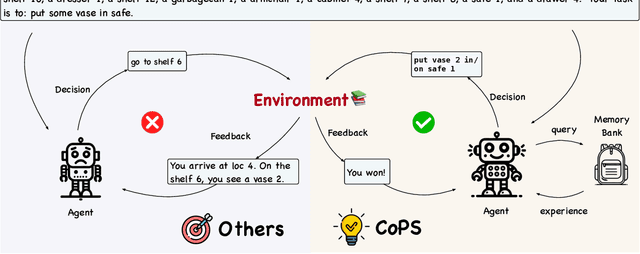
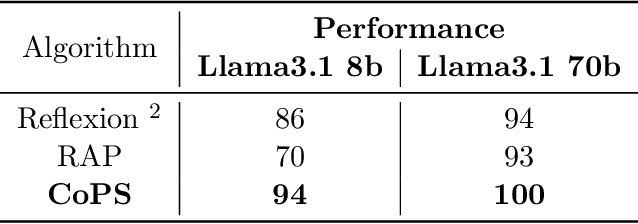
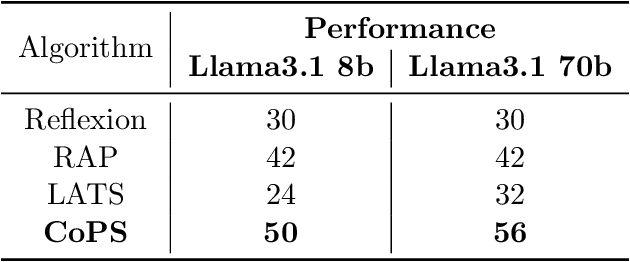
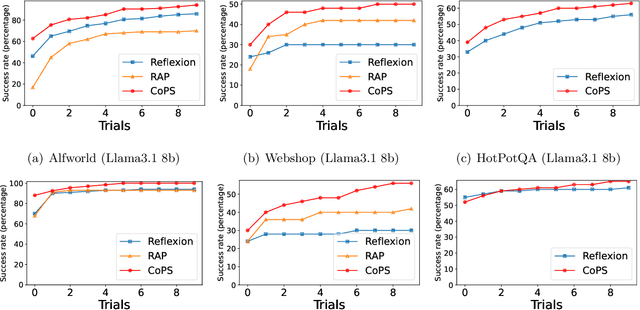
Abstract:Sequential reasoning in agent systems has been significantly advanced by large language models (LLMs), yet existing approaches face limitations. Reflection-driven reasoning relies solely on knowledge in pretrained models, limiting performance in novel scenarios, while experience-assisted reasoning often depends on external experiences and lacks clear principles for selecting representative experiences. We address these limitations by proposing CoPS (Cross-Task Experience Sharing), a generalizable algorithm that enhances sequential reasoning by cross-task experience sharing and selection. In detail, CoPS leverages agents' experiences on previous tasks, selecting distribution-matched experiences via a provable pessimism-based strategy to maximize utility while minimizing risks from distribution shifts. Extensive experimental results on benchmarks like Alfworld, Webshop, and HotPotQA demonstrate that CoPS consistently outperforms state-of-the-art baselines, with superior sample efficiency suitable for resource-constrained scenarios. Theoretically, we show that the performance of our algorithm depends on both the quality of the pretrained LLM and the matching between the agent's task-dependent trial distribution and that generated by the LLM. Our work bridges the gap between existing sequential reasoning paradigms and validates the effectiveness of leveraging cross-task experiences, shedding light on the potential to improve agents' generalization and adaptability across diverse tasks. Our codes are available at $\href{https://github.com/uclaml/COPS}{\text{https://github.com/uclaml/COPS}}$.
How to Build a Pre-trained Multimodal model for Simultaneously Chatting and Decision-making?
Oct 21, 2024



Abstract:Existing large pre-trained models typically map text input to text output in an end-to-end manner, such as ChatGPT, or map a segment of text input to a hierarchy of action decisions, such as OpenVLA. However, humans can simultaneously generate text and actions when receiving specific input signals. For example, a driver can make precise driving decisions while conversing with a friend in the passenger seat. Motivated by this observation, we consider the following question in this work: is it possible to construct a pre-trained model that can provide both language interaction and precise decision-making capabilities in dynamic open scenarios. We provide a definitive answer to this question by developing a new model architecture termed Visual Language Action model for Chatting and Decision Making (VLA4CD), and further demonstrating its performance in challenging autonomous driving tasks. Specifically, we leverage LoRA to fine-tune a pre-trained LLM with data of multiple modalities covering language, visual, and action. Unlike the existing LoRA operations used for LLM fine-tuning, we have designed new computational modules and training cost functions for VLA4CD. These designs enable VLA4CD to provide continuous-valued action decisions while outputting text responses. In contrast, existing LLMs can only output text responses, and current VLA models can only output action decisions. Moreover, these VLA models handle action data by discretizing and then tokenizing the discretized actions, a method unsuitable for complex decision-making tasks involving high-dimensional continuous-valued action vectors, such as autonomous driving. The experimental results on CARLA validate that: (1) our proposed model construction method is effective; (2) compared to the SOTA VLA model, VLA4CD can provide more accurate real-time decision-making while retaining the text interaction capability inherent to LLMs.
Configurable Foundation Models: Building LLMs from a Modular Perspective
Sep 04, 2024



Abstract:Advancements in LLMs have recently unveiled challenges tied to computational efficiency and continual scalability due to their requirements of huge parameters, making the applications and evolution of these models on devices with limited computation resources and scenarios requiring various abilities increasingly cumbersome. Inspired by modularity within the human brain, there is a growing tendency to decompose LLMs into numerous functional modules, allowing for inference with part of modules and dynamic assembly of modules to tackle complex tasks, such as mixture-of-experts. To highlight the inherent efficiency and composability of the modular approach, we coin the term brick to represent each functional module, designating the modularized structure as configurable foundation models. In this paper, we offer a comprehensive overview and investigation of the construction, utilization, and limitation of configurable foundation models. We first formalize modules into emergent bricks - functional neuron partitions that emerge during the pre-training phase, and customized bricks - bricks constructed via additional post-training to improve the capabilities and knowledge of LLMs. Based on diverse functional bricks, we further present four brick-oriented operations: retrieval and routing, merging, updating, and growing. These operations allow for dynamic configuration of LLMs based on instructions to handle complex tasks. To verify our perspective, we conduct an empirical analysis on widely-used LLMs. We find that the FFN layers follow modular patterns with functional specialization of neurons and functional neuron partitions. Finally, we highlight several open issues and directions for future research. Overall, this paper aims to offer a fresh modular perspective on existing LLM research and inspire the future creation of more efficient and scalable foundational models.
SELF-GUIDE: Better Task-Specific Instruction Following via Self-Synthetic Finetuning
Jul 16, 2024



Abstract:Large language models (LLMs) hold the promise of solving diverse tasks when provided with appropriate natural language prompts. However, prompting often leads models to make predictions with lower accuracy compared to finetuning a model with ample training data. On the other hand, while finetuning LLMs on task-specific data generally improves their performance, abundant annotated datasets are not available for all tasks. Previous work has explored generating task-specific data from state-of-the-art LLMs and using this data to finetune smaller models, but this approach requires access to a language model other than the one being trained, which introduces cost, scalability challenges, and legal hurdles associated with continuously relying on more powerful LLMs. In response to these, we propose SELF-GUIDE, a multi-stage mechanism in which we synthesize task-specific input-output pairs from the student LLM, then use these input-output pairs to finetune the student LLM itself. In our empirical evaluation of the Natural Instructions V2 benchmark, we find that SELF-GUIDE improves the performance of LLM by a substantial margin. Specifically, we report an absolute improvement of approximately 15% for classification tasks and 18% for generation tasks in the benchmark's metrics. This sheds light on the promise of self-synthesized data guiding LLMs towards becoming task-specific experts without any external learning signals.
Internet of Agents: Weaving a Web of Heterogeneous Agents for Collaborative Intelligence
Jul 10, 2024Abstract:The rapid advancement of large language models (LLMs) has paved the way for the development of highly capable autonomous agents. However, existing multi-agent frameworks often struggle with integrating diverse capable third-party agents due to reliance on agents defined within their own ecosystems. They also face challenges in simulating distributed environments, as most frameworks are limited to single-device setups. Furthermore, these frameworks often rely on hard-coded communication pipelines, limiting their adaptability to dynamic task requirements. Inspired by the concept of the Internet, we propose the Internet of Agents (IoA), a novel framework that addresses these limitations by providing a flexible and scalable platform for LLM-based multi-agent collaboration. IoA introduces an agent integration protocol, an instant-messaging-like architecture design, and dynamic mechanisms for agent teaming and conversation flow control. Through extensive experiments on general assistant tasks, embodied AI tasks, and retrieval-augmented generation benchmarks, we demonstrate that IoA consistently outperforms state-of-the-art baselines, showcasing its ability to facilitate effective collaboration among heterogeneous agents. IoA represents a step towards linking diverse agents in an Internet-like environment, where agents can seamlessly collaborate to achieve greater intelligence and capabilities. Our codebase has been released at \url{https://github.com/OpenBMB/IoA}.
MiniCPM: Unveiling the Potential of Small Language Models with Scalable Training Strategies
Apr 09, 2024


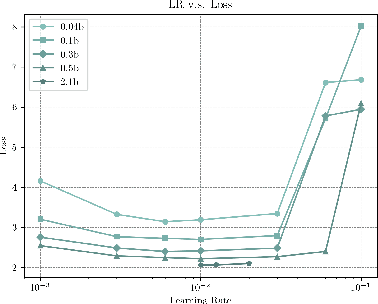
Abstract:The burgeoning interest in developing Large Language Models (LLMs) with up to trillion parameters has been met with concerns regarding resource efficiency and practical expense, particularly given the immense cost of experimentation. This scenario underscores the importance of exploring the potential of Small Language Models (SLMs) as a resource-efficient alternative. In this context, we introduce MiniCPM, specifically the 1.2B and 2.4B non-embedding parameter variants, not only excel in their respective categories but also demonstrate capabilities on par with 7B-13B LLMs. While focusing on SLMs, our approach exhibits scalability in both model and data dimensions for future LLM research. Regarding model scaling, we employ extensive model wind tunnel experiments for stable and optimal scaling. For data scaling, we introduce a Warmup-Stable-Decay (WSD) learning rate scheduler (LRS), conducive to continuous training and domain adaptation. We present an in-depth analysis of the intriguing training dynamics that occurred in the WSD LRS. With WSD LRS, we are now able to efficiently study data-model scaling law without extensive retraining experiments on both axes of model and data, from which we derive the much higher compute optimal data-model ratio than Chinchilla Optimal. Additionally, we introduce MiniCPM family, including MiniCPM-DPO, MiniCPM-MoE and MiniCPM-128K, whose excellent performance further cementing MiniCPM's foundation in diverse SLM applications. MiniCPM models are available publicly at https://github.com/OpenBMB/MiniCPM .
 Add to Chrome
Add to Chrome Add to Firefox
Add to Firefox Add to Edge
Add to Edge